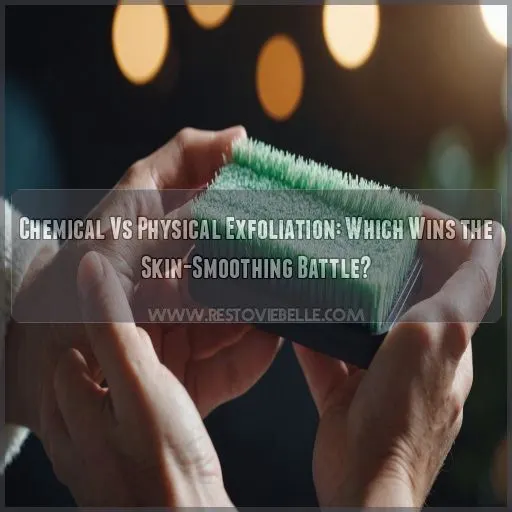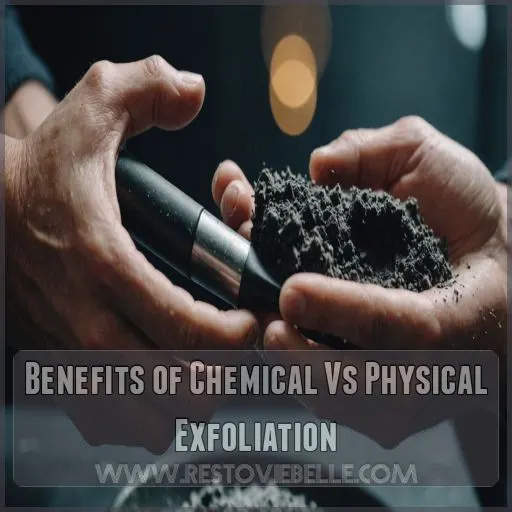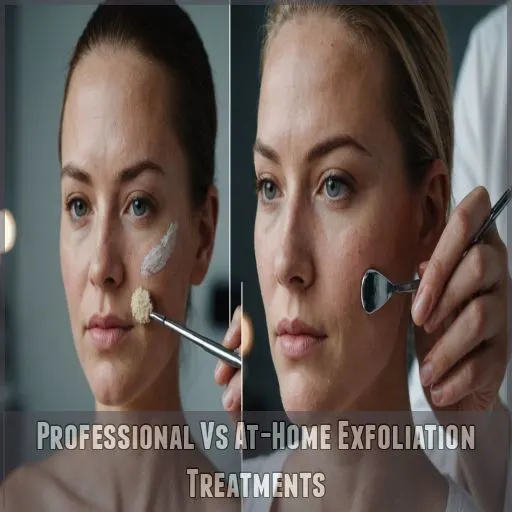This site is supported by our readers. We may earn a commission, at no cost to you, if you purchase through links.
 Choosing between chemical and physical exfoliation is like picking your favorite ice cream—each has its perks! Chemical exfoliation uses alpha and beta hydroxy acids to dissolve dead skin cells, making it a gentle choice for sensitive or aging skin. It’s like ordering a scoop that melts precisely, revealing smoother, brighter skin every time.
Choosing between chemical and physical exfoliation is like picking your favorite ice cream—each has its perks! Chemical exfoliation uses alpha and beta hydroxy acids to dissolve dead skin cells, making it a gentle choice for sensitive or aging skin. It’s like ordering a scoop that melts precisely, revealing smoother, brighter skin every time.
Meanwhile, physical exfoliation gets hands-on with scrubs or brushes, buffing away debris, which works wonders for oily, acne-prone skin. Think of it as the reliable classic that adds texture.
Each method has unique benefits, but which will you scoop up for a flawless finish? Discover more inside!
Table Of Contents
- Key Takeaways
- Defining Chemical and Physical Exfoliation Methods
- Benefits of Chemical Vs Physical Exfoliation
- Skin Types and Exfoliation Preferences
- Frequency and Application Techniques
- Potential Risks and Side Effects
- Effectiveness for Specific Skin Concerns
- Combining Chemical and Physical Exfoliation Methods
- Professional Vs At-Home Exfoliation Treatments
- Exfoliation in Different Climates and Seasons
- Frequently Asked Questions (FAQs)
- Conclusion
Key Takeaways
- Chemical and physical exfoliation are like different movie genres—each has its fans. Chemical exfoliants, with acids like AHAs and BHAs, are great for sensitive skin, as they dissolve dead cells gently. Physical exfoliants, using scrubs or brushes, are like action movies for your skin, perfect for oily and acne-prone skin types.
- Think of chemical exfoliation as the quiet book-lover and physical exfoliation as the enthusiastic workout buddy. Chemical options enhance collagen and fight aging signs gracefully. Meanwhile, physical methods improve texture by buffing sun damage while giving your skin a good workout.
- Mixing both methods is like crafting the perfect playlist—you get a little of everything. Alternate between them to tackle issues like dullness or uneven tones, keeping your skin looking fresh without overdoing it.
- Remember, your skin’s needs might change with the seasons—high humidity demands less frequent exfoliation, while winter’s dryness asks for gentle care. So adapt your approach like you’d change your wardrobe for summer and winter.
Defining Chemical and Physical Exfoliation Methods
You’ve probably heard about exfoliation, but do you know the difference between chemical and physical methods?
Let’s explore these two approaches to skin renewal, understanding how they work and what sets them apart in the quest for smoother, brighter skin.
Chemical Exfoliants: AHAs, BHAs, and Enzymes
When it comes to chemical exfoliants, you’ll find three powerhouses: AHAs, BHAs, and enzymes. These skin-smoothing superheroes work their magic by dissolving dead cells, revealing your radiant complexion underneath.
Physical Exfoliants: Scrubs, Brushes, and Cloths
With physical exfoliants, you’re taking matters into your own hands. Scrubs, brushes, and cloths are your go-to tools for sloughing away dead skin cells and revealing a smoother complexion.
Mechanisms of Action for Both Methods
You’ve seen the tools, now let’s explore how they work. Chemical and physical exfoliation have distinct mechanisms:
- Chemical: Dissolves bonds between dead cells
- Physical: Manually sloughs off dead skin
- Both: Boost cell turnover
Common Ingredients in Chemical Exfoliants
Chemical exfoliants are your skin’s secret weapon.
Let’s take a closer look at the common ingredients that’ll have you glowing:
| Ingredient | Type | Benefits | Best For |
|---|---|---|---|
| Glycolic Acid | AHA | Brightens, smooths | All skin types |
| Salicylic Acid | BHA | Unclogs pores | Oily, acne-prone |
| Lactic Acid | AHA | Hydrates, exfoliates | Sensitive, dry |
| Fruit Enzymes | Enzyme | Gentle exfoliation | Sensitive |
Chemical exfoliants are a great way to improve your skin’s appearance and reduce the signs of aging.
Types of Abrasives Used in Physical Exfoliants
Physical exfoliants come in various forms, each offering unique benefits.
From natural options like sugar and salt to synthetic beads, these gritty heroes work to buff away dead skin cells, revealing smoother textures underneath.
Benefits of Chemical Vs Physical Exfoliation
If you’re thinking about exfoliating your skin, chemical and physical methods each offer their unique benefits, leaving you wondering which is the real crème de la crème of skin-smoothing.
Whether you’re looking to pamper sensitive skin with gentle acids or give oily skin a scrubbing workout, understanding these benefits is key to achieving that fresh, radiant glow without turning your face into sandpaper.
Effectiveness On Skin Types
So, you’ve dipped your toe into exfoliation. Now, finding the right fit for your skin type is like choosing the perfect pair of shoes.
Chemical exfoliation often suits sensitive or aging skin, while physical works wonders on oily, acne-prone, or combination complexions.
Gentleness And Irritation Potential
Gentle chemical exfoliants are generally less irritating than physical scrubs, especially for sensitive skin types.
Pay close attention to how your skin reacts – redness, dryness, or stinging signals it’s time to dial back the intensity.
Long-Term Skin Benefits
Sure, exfoliation isn’t all about gentleness.
When thinking long-term, chemical exfoliation can enhance collagen, fight hyperpigmentation, and curb acne.
Meanwhile, physical exfoliation offers improved skin texture by buffing away sun damage.
Imagine your skin as a radiant diamond in the rough!
Skin Types and Exfoliation Preferences
Choosing the right exfoliation method can feel like picking the perfect Netflix show—tricky but important!
You’ve got to match your skin’s personality, whether it’s sensitive, oily, or aging, to the right exfoliant to keep it looking its best.
Suitability of Chemical Exfoliation for Sensitive Skin
Chemical exfoliation can be your sensitive skin’s best friend, if done right. AHAs, like lactic acid, are gentle; always start slow, consider patch testing, and watch improvement.
Physical Exfoliation for Oily and Acne-prone Skin
If you have oily, acne-prone skin, physical exfoliants like micro-scrubs can slough off excess oil and dead cells, unclogging pores and preventing breakouts. Just don’t overdo it!
Combination Approaches for Normal Skin Types
Balancing both worlds, you might try gentle scrubs alongside an AHA/BHA combo. This routine gives your normal skin a glow without overdoing exfoliation frequency in your regimen.
Adapting Exfoliation Methods for Aging Skin
Aging skin, like a wise friend, needs gentle exfoliation. Consider chemical exfoliation for a collagen boost and improved product absorption while maintaining sensitivity to avoid irritation and fine lines.
Considerations for Dry and Dehydrated Skin
Dry skin often feels like a desert—thirsty for moisture. Prioritize hydration while exfoliating by focusing on:
- Gentle Ingredients
- Barrier Repair
- Ceramides
- Humectants
Frequency and Application Techniques
With exfoliating, timing is everything. Discover the recommended frequency for chemical exfoliants and the best practices for physical scrubs to achieve your smoothest, most radiant skin.
Recommended Frequency for Chemical Exfoliation
Using chemical exfoliation can feel like walking a tightrope. Generally, start exfoliating 1-2 times a week. Adjust based on your skin’s reaction.
Best Practices for Physical Exfoliation
Thinking about trying physical exfoliation? Follow these steps for success and peace of mind:
- Choose gentle exfoliating tools.
- Use scrubs with safe ingredients.
- Consider skin sensitivity.
Layering Chemical Exfoliants With Other Skincare Products
Ever wondered how to layer chemical exfoliants with other skincare products? Start with serums and toners before moisturizers and sunscreens to enhance chemical exfoliation benefits effortlessly.
Chemical Exfoliation
| Product Type | Order of Application | Ideal Use Time |
|---|---|---|
| Toners | After cleansing | Morning/Evening |
| Serums | Before moisturizers | Morning/Evening |
| Moisturizers | Post-serum | Morning/Evening |
| Sunscreens | Last step | Morning |
Proper Application Techniques for Physical Scrubs
Gently scrub in circular motions, not back-and-forth. Adjust pressure based on skin sensitivity. Use a soft washcloth or brush for physical exfoliation 1-2 times weekly.
Time Considerations for Chemical Exfoliant Effectiveness
When’s the best time to exfoliate with chemical methods? Consider overnight benefits. Remember:
- Adjust acid strength gradually.
- Maximize product absorption.
- Balance exfoliation frequency wisely.
Potential Risks and Side Effects
Getting a handle on exfoliation can be a bit like walking a skincare tightrope—balancing benefits against potential pitfalls.
Whether you’re dealing with chemical burns that feel like you accidentally face-planted a lemon or microtears resembling a sandpaper mishap, you need to understand the risks so you don’t over-exfoliate and end up with skin that’s more red than radiant.
Over-exfoliation Risks With Physical Methods
You’ve nailed your exfoliation routine, but too much scrubbing causes microtears and weakens skin barriers. Watch out for redness and irritation sneaking up like sunburn!
| Symptom | Cause | Solution |
|---|---|---|
| Redness | Over-exfoliation | Reduce exfoliation |
| Sensitivity | Skin Barrier Weakness | Apply soothing creams |
| Irritation | Microtears | Use gentler products |
| Sun damage | Excessive Exposure | Incorporate SPF |
Less is more with facial cleansing devices!
Chemical Burns and Irritation From Acids
Acids in chemical exfoliants can cause stinging, redness, and even chemical burns if not used properly. Always patch test and neutralize acids to protect your skin’s barrier.
- Patch test new chemical exfoliants on a small area first.
- Neutralize acids with a gentle cleanser or baking soda solution.
- Follow up with a nourishing moisturizer to soothe and replenish your skin.
Long-term Effects of Excessive Exfoliation
Exfoliation’s great, but overdo it and your skin might rebel! Too much can damage your skin barrier, causing acne flare-ups, increased sensitivity, redness, irritation, and even premature aging.
Photosensitivity Concerns With Chemical Exfoliants
Using chemical exfoliants? Watch out for photosensitivity! With increased sun sensitivity, it’s like forgetting your sunscreen—risky business. Prioritize SPF use to shield your skin from harm.
Microtears and Abrasions From Harsh Physical Scrubs
While chemical exfoliants pose photosensitivity risks, harsh physical scrubs might cause microtears damaging your skin barrier. Instead, explore exfoliation alternatives with gentle scrubbing tips and product recommendations for healing.
Effectiveness for Specific Skin Concerns
For specific skin concerns, chemical and physical exfoliation methods each have their own strengths.
Depending on your skin type and needs, one approach may prove more effective than the other in addressing issues like acne, hyperpigmentation, aging, and pore management.
Acne Treatment: Chemical Vs Physical Approaches
When acne strikes, both chemical and physical exfoliation can help. Salicylic acid targets acne-prone skin, while gentle scrubs offer a hands-on approach without harshness. So, what’s your style?
Addressing Hyperpigmentation and Dark Spots
Hyperpigmentation and dark spots giving you a run for your money? Consider these tried-and-true methods:
- Vitamin C serums
- Topical retinoids
- Sun protection
- Laser treatments
Combating Signs of Aging and Fine Lines
Fine lines got you down? Consider pairing chemical exfoliants with Retinol synergy for a collagen boost. Antioxidant power and lifestyle factors, like sun protection, keep aging at bay!
Improving Skin Texture and Tone
Exfoliate wisely to reveal smoother, brighter skin! Chemical peels and gentle scrubs work wonders, but moderation is key. Discover your perfect exfoliation routine for a luminous complexion.
Managing Enlarged Pores and Blackheads
Just like you mastered skin texture, tackling enlarged pores and blackheads is next. Explore pore-minimizing products, blackhead extraction tricks, oil control, and balanced exfoliation frequency for glowing skin.
Combining Chemical and Physical Exfoliation Methods
If you’re unsure whether to choose chemical or physical exfoliation, why not have the best of both worlds?
Combining these methods strategically lets you enjoy a smoother, brighter complexion while addressing various skin concerns effectively.
Synergistic Effects of Dual Exfoliation
How do you harness the magic of a dual exfoliation routine? By blending the benefits of combining:
- Skin texture improvement
- Minimizing irritation
- Individualized approach
- Enhanced absorption
- Balanced glow
Creating a Balanced Exfoliation Routine
Craft an exfoliation routine designed for your skin’s unique needs for a radiant, healthy glow – balance chemical and physical methods for best results.
Alternating Between Chemical and Physical Methods
Switching between chemical and physical exfoliation offers balance and customization. Consider these steps:
- Schedule alternating days.
- Adjust based on skin’s response.
- Prioritize comfort and effectiveness.
Precautions When Using Both Exfoliation Types
You’ve decided to mix chemical and physical exfoliation, but be wary. Monitor skin sensitivity, make sure products are compatible, balance frequency, and don’t forget your trusty sun protection.
Customizing Combinations for Different Skin Needs
Balancing chemical and physical exfoliation can address sensitive skin with gentler methods, tackle oily and acne-prone areas with deeper cleaning, and rejuvenate aging or combination skin effectively.
Professional Vs At-Home Exfoliation Treatments
For exfoliation, you have two main options: professional treatments or DIY at-home methods.
While professional chemical peels and microdermabrasion can deliver more dramatic results, you can also achieve smooth, radiant skin with carefully selected at-home exfoliants.
The key is finding the right balance for your unique skin type and concerns.
Chemical Peels in Professional Settings
You’re curious about professional chemical peels. These treatments offer various benefits:
- Improved skin texture.
- Better complexion.
- Safety measures are key.
- Costs and recovery time vary.
Microdermabrasion as a Physical Exfoliation Treatment
Wondering about skincare’s twists and turns? Microdermabrasion could be your road map. Comparing professional and home treatments showcases differences in cost, results, safety, and alternatives.
Professional Treatment and At-Home Kits offer different benefits.
| Aspects | Professional Treatment | At-Home Kit |
|---|---|---|
| Cost | High | Moderate |
| Results | Immediate | Gradual |
| Safety | Supervised | Self-managed |
DIY Chemical Exfoliation Masks and Serums
You’ve discovered the secret to radiant skin with DIY chemical exfoliation recipes. Choose quality ingredient sourcing, follow mask application tips, and remember safety precautions for longer shelf life.
At-home Physical Exfoliation Tools and Devices
Exfoliating brushes, DIY scrubs, and microdermabrasion tools let you take control of your skin’s glow. Just don’t overdo it – moderation is key for at-home exfoliation.
Safety Considerations for Professional-grade Exfoliants
Before diving into professional-grade exfoliants, remember their power requires oversight.
- Make sure you’re dealing with professionals and check the product concentration.
- Consider skin sensitivity and treatment frequency.
- Follow post-treatment care seriously.
Exfoliation in Different Climates and Seasons
You might think exfoliation is the same all year round, but your skin’s needs can change with the seasons.
Whether you’re basking in the summer sun or bracing against winter winds, adapting your exfoliation routine helps keep your skin looking radiant no matter the weather.
Adjusting Exfoliation for Humid Environments
Humidity can mess with your exfoliation routine. Sweat might boost product absorption, but don’t compromise your skin barrier. Adjust exfoliation frequency to keep the balance right.
Winter Skincare and Gentle Exfoliation Methods
During winter, your skin craves gentle exfoliation. Try a creamy scrub 1-2 times weekly, and always follow with a nourishing moisturizer to lock in hydration.
Chemical exfoliants are your best bet during the colder months.
- Avoid harsh physical exfoliants
- Focus on chemical exfoliants with AHAs
- Increase moisturizer application in dry air
- Limit exfoliation frequency to prevent irritation
Summer Exfoliation and Sun Protection
While cozy winter wraps often dull skin, summer beckons for glowing radiance! Remember SPF is your BFF. Tanning’s tempting, but sunburn’s a pesky exfoliation partner. Hydration’s key!
Travel Considerations for Exfoliation Routines
Jetting off? Reach for travel-size products. Airplane cabin humidity can dry skin like a desert. Mind those TSA restrictions—pack carry-on essentials! Smart packing keeps your glow intact.
Seasonal Changes in Skin and Exfoliation Needs
Traveling through climates shouldn’t leave your skin feeling like a raisin in the desert. Balance your exfoliation needs with seasonal changes:
- Embrace gentler exfoliation in winter’s dryness.
- Tackle excess oil during humid summers.
- Prioritize sun protection with summer skincare.
- Adapt routines based on skin’s seasonal behavior.
Frequently Asked Questions (FAQs)
How do I choose the right exfoliant for my skin type?
Consider your skin’s mood!
Got sensitive skin? Chemical exfoliants are your gentle pals.
Dealing with dullness and stubborn spots? Physical exfoliants are like a loofah for your face.
Always test patch—better safe than sorry!
What are the long-term effects of over-exfoliating?
Over-exfoliating can leave your skin feeling like a desert, causing irritation, redness, and even micro-tears.
You upset your skin’s natural balance, making it more sensitive and prone to breakouts.
Less is indeed more with exfoliation!
Can exfoliation help with ingrown hairs?
Exfoliation can help prevent ingrown hairs by freeing your trapped skin from hair’s embrace, giving it space to grow properly.
Just keep it gentle to avoid annoying skin irritation.
How do I incorporate exfoliation into my daily routine?
Incorporate exfoliation into your daily routine 2-3 times a week.
Start gently, then gradually increase frequency as your skin adjusts.
Exfoliate at night to allow your skin to renew while you sleep.
It’s a game-changer for glowing, healthy skin!
Are there any natural alternatives to chemical exfoliants?
You can try natural exfoliants like honey or yogurt—they’ve got gentle enzymes!
Oatmeal’s great for sensitive skin, while mashed fruits like papaya pack a punch with natural acids.
Just remember, balance is key!
Conclusion
When deciding between chemical and physical exfoliation, there’s more than one way to skin the cat. Each method offers unique benefits suited to different skin types and concerns.
Chemical exfoliation, with its gentle acid-based approach, works wonders for sensitive or aging skin, while physical exfoliation’s tactile method suits oily or acne-prone types.
Consider your skin’s specific needs and lifestyle to decide if you prefer the precision of chemical vs physical exfoliation’s straightforward touch.














